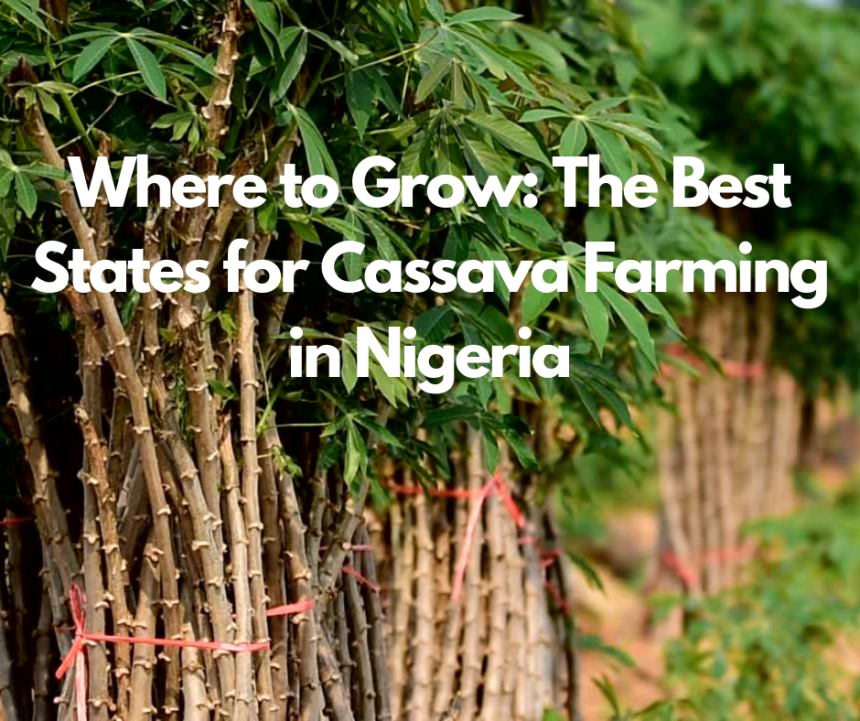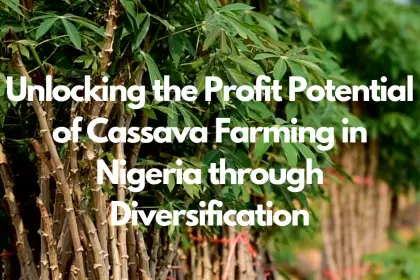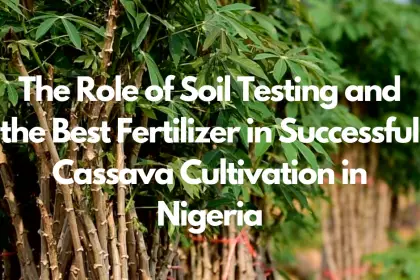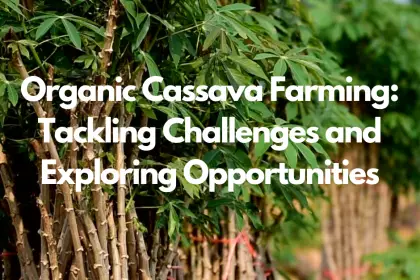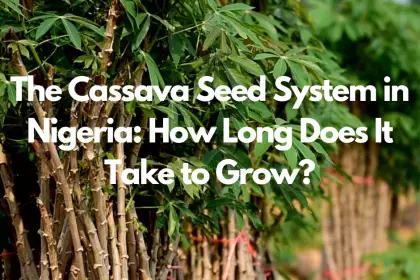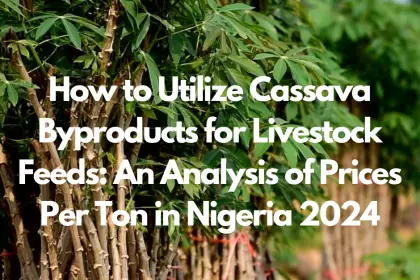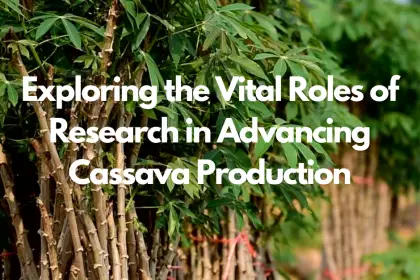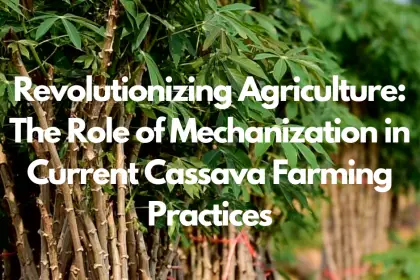Nigeria stands as the world’s leading producer of cassava, with a staggering annual production of approximately 45 million metric tons, representing nearly 19% of the global output 1. This remarkable yield is spread across 24 of the country’s 36 states, predominantly in the southern regions, where cassava farming in Nigeria has become synonymous with both economic sustenance and a major cash crop. The significance of this agricultural activity is further underscored by the Nigerian government’s efforts to boost self-sufficiency and reduce imports of rice and wheat by promoting the use of cassava and spearheading initiatives like the introduction of vitamin A-rich varieties to enhance nutritional value 1.
Despite the booming production, cassava farming in Nigeria faces challenges such as pests, diseases, and agronomic issues that hinder further growth. However, the country’s vast farmland, the strategic implementation of crop rotation, careful soil preparation, and effective weed control have played pivotal roles in expanding the harvested area by 18% between 2000 and 2011, significantly boosting production 3. Additionally, the focus on improving soil pH and fertility, coupled with measures against land degradation, showcases Nigeria’s commitment to not only maintaining its status as a top producer but also ensuring the crop’s vital role in food security and rural development 2 3.
Ogun State
In Ogun State, the government has initiated a commendable approach towards enhancing cassava production, focusing on educating farmers on the adoption of best agricultural practices. These practices are designed to not only increase yield per hectare but also ensure food security within Region 5. The key components of these best agricultural practices include the following:
- Proper Land Preparation: Ensuring the soil is adequately prepared for planting.
- Use of Quality Stems: Selecting high-yield cassava varieties for planting.
- Adequate Spacing of Crops: Implementing the right spacing to reduce competition for nutrients.
- Application of Appropriate Fertilizers and Insecticides: Using the Right Inputs to Enhance Growth and Protect the Crops from Pests and Diseases.
- Farm Maintenance: Regular monitoring and maintenance of the cassava farm.
- Improved Harvesting Methods: Adopting techniques that increase efficiency and reduce post-harvest losses 5.
A shining example of the success of these practices is the demonstration farm in Alagada village near Oba, which recorded a remarkable harvest of 51 tonnes per hectare using the TME 419 cassava variety. This figure starkly contrasts with the traditional farming methods’ average yield of 17 tonnes per hectare, showcasing the significant impact of adopting modern agricultural techniques 5.
Plans are in motion to replicate this model of success across four other local government areas within Ogun State. This expansion aims to help more farmers increase their yields, ensure food security, and maximize profits by adopting these best practices. The initiative is a testament to the positive relationship between farmers’ experience and on-farm cassava biodiversity, emphasizing the importance of arable land size in achieving higher biodiversity indices. However, it’s also noted that there is a negative relationship between the land squared variable and biodiversity indices, suggesting the need for appropriate agricultural land reforms to foster on-farm cassava biodiversity effectively 5 6.
Ogun State’s dedication to improving cassava production is further highlighted by its position among the top 20 cassava-producing states in Nigeria. This recognition underscores the potential and existing capabilities within the state to contribute significantly to Nigeria’s status as a leading cassava producer on the global stage 7.
Delta State
In Delta State, the dynamics of cassava farming reflect a blend of traditional knowledge and emerging needs for modern agronomic practices. A study in Oshimili North Local Government Area revealed a demographic profile where the majority of cassava farmers were male (55%), and most households comprised at least five members (61%) 8. This demographic foundation underpins the cassava farming activities in the region, where the mean farm size dedicated to cassava production is reported at 1.5 hectares, yielding an average output of 1,500kg 8. Despite high awareness of agronomic practices, there’s a noticeable gap in knowledge regarding the use of agro-chemicals, underscoring a critical area for development 8.
Key information needs and challenges:
- Use of Herbicides: The highest information need among cassava farmers in the state is the use of herbicides (78.8%), indicating a significant demand for knowledge on effective weed control measures 8.
- Pesticide Application: Following closely is the need for information on pesticide application (60.0%), highlighting concerns over pest management 8.
- Fertilizer Application: Knowledge on the right fertilizer application stands as another notable need (42.5%), pointing towards efforts to enhance soil fertility and yield 8.
Addressing these needs is crucial, especially considering the state’s significant role as one of Nigeria’s major cassava-producing states 1. However, challenges persist, notably in disease control and environmental sustainability. Research underscores the poor annual extension contacts (1.68) among farmers, which hampers the effective dissemination of critical knowledge and practices for disease management and control 9. Furthermore, a study in Ika North East Local Government Area revealed a concerning lack of awareness (51.3%) about the environmental impacts of small-scale cassava mill effluent, suggesting an urgent need for enhanced environmental education and reliable information dissemination 10.
To bolster cassava production in Delta State effectively, the following recommendations are put forward:
- Urgent and Good Extension Contact: There’s a pressing need for improved extension services to bridge the knowledge gap, especially in disease control and the use of agro-chemicals 9.
- Government Policy on Enlightenment: Good government policies are essential to enlighten farmers, not just to improve their knowledge but also to encourage the adoption of sustainable and productive cassava farming practices 9.
- Enhanced Environmental Education: Given the significant correlation between demographic factors and awareness of environmental impacts, targeted environmental education programs are recommended to foster sustainable cassava production practices 10.
These measures are imperative to not only address the current challenges but also to leverage Delta State’s potential to significantly contribute to Nigeria’s status as a global leader in cassava production.
Benue State
Benue State has emerged as a lucrative spot for cassava farming, attributed to its increasing popularity and profitability. The state has seen farmers expand their cassava fields each season to boost production, amidst a growing shift from traditional yam consumption to cassava. This transition is fueled by the high demand and price of cassava chips, making cassava farming an attractive venture. Despite the challenges posed by insecurity, such as herders’ attacks leading to the loss of stems and tubers, cassava farming in Benue State thrives with minimal waste. The introduction of new improved cassava varieties, which mature within five to seven months, with the eight-month maturity period deemed most suitable for harvesting, further propels production forward 11.
Key Practices for Enhanced Cassava Yield in Benue State:
- Proper weed control and farm sanitation are essential for preventing crop competition and disease spread.
- Use of Inputs: Application of fertilizers and herbicides is crucial for boosting cassava growth and yield 11.
- High-Yield Cassava Stems: Planting high-yield cassava stems is recommended over merely expanding the cropped area for sustained production 4.
Benue State’s strategic position, being close to the North where cassava is not produced, coupled with the rising cost of garri, has turned cassava farming into a highly profitable endeavor. The state boasts arable land and labor, making it a significant contributor to Nigeria’s cassava production. With the potential to produce over 2 million metric tons of cassava annually, Benue State stands among the top 5 cassava-producing states in Nigeria, alongside Taraba, Kogi, Imo, and Cross River, collectively accounting for 44.05% of the country’s total cassava production. This achievement is supported by the state’s agro-ecological conditions, suitable soil types, and the cassava crop’s resilience to low soil fertility and drought. To further enhance cassava farming and processing, the state has established cassava processing zones equipped with necessary facilities and provides training and extension services to farmers 2 4 11 12 13.
Anambra State
Anambra State, nestled in Nigeria’s fertile regions, emerges as a beacon for cassava production, buoyed by a blend of favorable meteorological and soil conditions. Research employing GIS-based multi-criteria analysis has pinpointed the dry rainforest and southern Guinea savanna, which collectively form 80% of Anambra’s landscape, as prime zones for cassava cultivation. This analysis underscores the pivotal roles of sunshine hours and rainfall as the significant climatic parameters influencing cassava farming success in the state. With projections indicating an average annual rainfall range of 565–3,193 mm and a daily temperature span of 24.57–31.94 °C for the forthcoming decades, Anambra’s climatic future seems conducive to cassava farming expansion, provided there’s an emphasis on soil fertility enhancement and the introduction of irrigation in northern marginal zones to optimize yields 14.
The socio-economic backdrop of cassava farming in Anambra State further accentuates its potential. A majority of cassava farmers in the region are male (78%), with an average age of 45.46 years and an impressive mean farming experience of 13.71 years. Notably, about 66% of these farmers are members of cooperative associations, and a significant 67% have access to credit facilities. These socio-economic characteristics are instrumental in adopting various climate change adaptation practices, including farming system adjustments, crop diversification, organic manuring, and the use of improved crop varieties. Such practices not only bolster cassava productivity but also signify the readiness of Anambra’s farming community to embrace innovative and sustainable farming methods 15.
The documented challenges and opportunities in Anambra State, coupled with its climatic and soil requisites for cassava farming, lay a solid foundation for future endeavors in this domain. The state’s alignment with recommended farming practices, such as multiple planting dates and alternate fallowing, positions it as a fertile ground for cassava farming. With Anambra being one of the major cassava-producing states, the insights from the “Gauging Cassava Land Use Trends in Nigeria’s Lower South Region” paper offer a glimpse into the evolving landscape of cassava cultivation. This evolving landscape, marked by changes in cassava land use indicators and the looming threats to the surrounding ecology, underscores the necessity for a regional cassava land resource information system to guide sustainable cultivation practices 16 17.
Cross River State
Cross River State stands at the forefront of cassava production in Nigeria, with a comprehensive approach that integrates traditional practices with modern advancements to optimize output. The state’s commitment is evident in several key areas:
- Land and Population Engagement:
- Government Initiatives and Policy Support:
- The introduction of the Cassava Draft Policy, backed by the Cross River State House of Assembly, aims to modernize cassava cultivation and processing techniques. This policy framework is designed to not only provide land for cassava cultivation but also contribute to the industrialization of Nigeria and the financial emancipation of the people 18.
- Establishment of a cassava processing plant in Obubra Local Government Area with the capacity to produce commercial starch and modified flour. This facility is expected to increase the availability of garri and reduce its cost, benefiting both consumers and producers 19.
- Challenges and Strategic Directions:
- Despite the robust framework and significant land allocation, challenges persist, such as the bulk purchase of cassava products in the ready market. To mitigate this, merchants are encouraged to off-take products, thus motivating farmers to cultivate more 20.
- The private sector’s deliberate efforts to transform the agricultural sector, particularly the cassava value chain, highlight a move towards a more productive state, with cassava being a key driver of this productivity. The emphasis is on using improved varieties and modern technology to optimize production capacity and guarantee a good yield 20.
Cross River State’s approach to cassava farming exemplifies a balanced integration of policy support, community engagement, and technological advancement. This strategy not only positions the state as a leader in cassava production in Nigeria but also sets a benchmark for sustainable and profitable agricultural practices in the region.
Conclusion
As we journey through the rich tapestry of cassava farming in Nigeria, we appreciate the varied landscapes, from Ogun to Cross River, each weaving its own unique strand into the fabric of Nigeria’s agricultural prowess. These states, distinguished by their innovative approaches and commitment to enhancing cassava production, underscore the essential role of knowledge dissemination, policy support, and community engagement in ensuring sustainable growth within the sector. The continuous evolution of cassava farming practices, coupled with strategic government initiatives, not only fortifies Nigeria’s position as a global leader in cassava production but also promises enhanced food security and economic prosperity for its burgeoning population.
Reflecting on the insights garnered, the significance of tailored agricultural practices, environmental consciousness, and the incorporation of modern technologies emerge as pivotal for the future of cassava farming in Nigeria. The challenges outlined, though varied, present opportunities for collaborative efforts towards addressing knowledge gaps, improving yield, and ensuring environmental sustainability. As Nigeria strides towards optimizing its cassava production capabilities, the journey encapsulates a broader narrative of resilience, innovation, and the enduring spirit of its people to harness the full potential of their land, offering valuable lessons for similar endeavors globally.
FAQs
What is the leading state in Nigeria for cassava production?
Benue State is recognized as the foremost producer of cassava in Nigeria.
Which state is known for producing the highest-quality Garri?
Currently, the finest garri is said to come from Ngwa in Aba, Abia State. However, it is produced in limited quantities, making it somewhat rare.
Which region holds the title for the largest cassava production worldwide?
Nigeria is the world’s top producer of cassava, surpassing Brazil’s production by a third and nearly doubling the output of Indonesia and Thailand.
When is the ideal time to plant cassava in Nigeria?
The optimal period for planting cassava in Nigeria is from April to September or October. Cassava stems should be planted on ridges that are roughly 40 cm wide and 40–60 cm high. For best growth, it is advisable to apply fertilizer to the plants 8–10 weeks after planting the stems.
References
[1] https://en.wikipedia.org/wiki/Cassava_production_in_Nigeria [2] – https://www.fao.org/3/a0154e/A0154E05.htm [3] – https://agricdemy.com/post/cassava-farming-introduction [4] – https://www.ncbi.nlm.nih.gov/pmc/articles/PMC7553005/ [5] – https://businessday.ng/agriculture/article/ogun-train-farmers-best-agro-practises/ [6] – https://www.tandfonline.com/doi/full/10.1080/21513732.2015.1071282 [7] – https://www.onlineworld.ng/2023/02/cassava-producing-states.html [8] – https://www.ajol.info/index.php/tjags/article/view/130219 [9] – https://www.degruyter.com/document/doi/10.1515/opag-2019-0017/html?lang=en [10]: https://link.springer.com/article/10.1007/s10661-023-12026-7 [11]: – https://dailytrust.com/how-cassava-is-becoming-gold-in-benue/ [12]: https://maxwellsci.com/print/crjss/v3-406-411.pdf [13]: https://knoema.com/atlas/Nigeria/ranks/Production-of-Cassava [14] – https://www.ncbi.nlm.nih.gov/pmc/articles/PMC6985172/ [15] – https://www.ncbi.nlm.nih.gov/pmc/articles/PMC10036664/ [16] – https://www.ajol.info/index.php/jafs/article/view/189401/178632 [17] – http://article.sapub.org/10.5923.j.food.20221201.01.html [18] – https://www.researchgate.net/publication/298177140_Resource_use_efficiency_of_small-holder_farmers_The_case_of_cassava_producers_in_Cross_River_State_Nigeria [19] – https://dailytrust.com/cross-river-gets-cassava-processing-plant/ [20] – https://news.crossriverstate.gov.ng/well-transform-cassava-into-oil-wells-of-cross-river-investors-vow/

